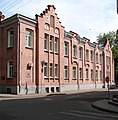Max Hoeppener
Wilhelm Eduard Maximilian Karlowitsch Hoeppener ( Russian Вильгельм-Эдуард Максимилиан Карлович Геппенер ; * June 4 jul. / June 16, 1848 greg. In Moscow ; † December 10, 1924 in Moscow) was a Russian architect .
Life
Max Hoeppener was the son of a Baltic German family (the later Reval banker Edgar Hoeppener was his cousin and the Reval entrepreneur and councilor Eduard Hoeppener was his grandfather). He attended school at the Lutheran St. Peter and Paul Cathedral and then the Third Moscow Secondary School . 1865–1869 he studied civil engineering at the Technical University in Karlsruhe . During his studies, he repeatedly went to Moscow to carry out smaller construction contracts. In 1870 he was involved in the construction of a museum and library in the Grand Duchy of Baden under the direction of the senior building officer Karl Josef Berkmüller.
After his return to Moscow in 1871, Hoeppener worked as an assistant to the Moscow architect Alexander Stepanowitsch Kaminski . In the same year he was recognized by the Imperial Art Academy for the execution of a concert hall project as a freelance artist .
In 1876 Hoeppener was appointed architect of the Moscow orphanage. 1876–1879 he built the bell tower of Moscow's Nicholas Monastery of the Old Orthodox . From 1877 he worked in the Moscow city administration and became a member of the building committee (until 1913). He was thus involved in all major Moscow building projects: the third Mytishchi- Moscow aqueduct, whose water towers he built from 1890 to 1893, the Moscow tram , the construction of schools, homes and high schools. 1879-1893 he was also the architect of the Nikolai Orphanage and the Alexander Orphan School. In 1879 he joined the Moscow Architectural Society.
From 1881 to 1895 Hoeppener was a member of the board of directors of the school for evangelical poor and orphans . Together with Carl Gustav Jacoby, he built the Petri Realschule in Reval , which was completed in 1883. He built the Sokolniki fire station in Moscow (1884) and the Trinity Church in Kolomna (1887–1907). From 1894 to 1899 he was the architect of the Ministry of Foreign Affairs and in 1898 also that of the administration of the Moscow girls' high schools. In the early 1890s, the young Illarion Alexandrowitsch Ivanov-Schitz worked with him as an intern, with whom he later built the AS Khomyakov apartment building and in 1914 developed designs for tender competitions. His Revaler cousin Charlotte Hoeppener (* February 4, 1863 - November 7, 1934), sister of the banker Edgar Hoeppener , whose Reval villa he had designed, worked as a draftsman . In 1905 he was elected chairman of the architects' association, but the following year he resigned. In 1913 he became a member of the Moscow City Council's Technical Committee and headed the information office. In 1914 he was made an honorary member of the Moscow Architectural Society.
After the October Revolution , Hoeppener worked from 1918 in the consultative office of the building department of the Moscow Workers' Council. In 1921 he moved to the architectural group of the structural engineering committee and became deputy head of the department for cultural institutions. In 1922 he became a chief architect in the administration of the Moscow governorate architect. He retired in 1923.
Hoeppener found his grave in Moscow's Vvedenskoye Cemetery , which has not been preserved. In 2011 a cenotaph with his bust made by the sculptor Nikolai Avakumov was set up there.
Hoeppener was married to Agrippina Fyodorovna Kasakowa and had two daughters, Helene († October 21, 1976) and Antonina.
Honors
- Order of Saint Anne III Class (1888)
- Order of Saint Stanislaus II Class (1894)
- Order of Saint Anne II Class (1897)
- Order of Saint Vladimir IV Class (1901)
- Medal of Honor for the 51st anniversary of the birth of Emperor Alexander III.
- Medal of Honor for the coronation of Emperor Nicholas II.
Works
literature
- EA Winnitschek, TF Kuznetsova, AS Panina: The Moscow architect Maxim Karlowitsch Hoeppener - known and unknown. Ed. Sergej Andrijaka's watercolor school (State Technical School). (Russian, accessed September 15, 2015)
- Maria Naschtschokina : Architektory moskowskogo moderna: tworcheskie portrety. Schiraf Verlag, Moscow 2005, ISBN 5-89832-043-1 , pp. 222-231 (Russian).
Web links
Individual evidence
- ↑ Karsten Brüggemann , Ralph Tuchtenhagen : Tallinn: a small history of the city. Böhlau Verlag , Cologne / Weimar 2011, p. 178.
- ↑ Carola L. Goltz man, Petra horns: Dictionary of German literature of the Baltic and St. Petersburg: From the Middle Ages to the present. Volume 2, Verlag Walter de Gruyter , Berlin 2007, ISBN 978-3-11-019338-1 , p. 589.
| personal data | |
|---|---|
| SURNAME | Hoeppener, Max |
| ALTERNATIVE NAMES | Hoeppener, Wilhelm Eduard Maximilian Karlowitsch (full name); Геппенер, Вильгельм-Эдуард Максимилиан Карлович (Russian) |
| BRIEF DESCRIPTION | Russian architect |
| DATE OF BIRTH | June 16, 1848 |
| PLACE OF BIRTH | Moscow |
| DATE OF DEATH | December 10, 1924 |
| Place of death | Moscow |






